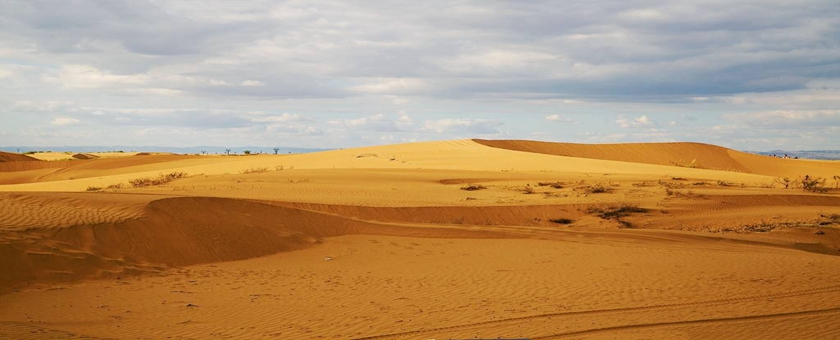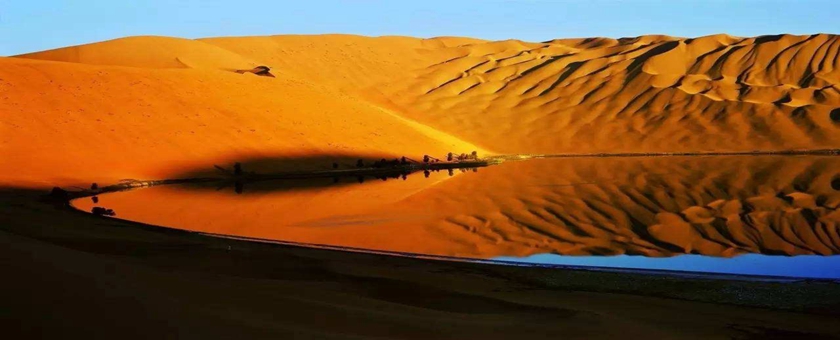- info@chinaadventure.org
- 86-18008011324
- Search
There are many deserts in Inner Mongolia. The deserts are located in the western part of the province. The most famous and visited ones are Badain Jaran Desert, Tengger Desert and Resonant Sand Gorge. Early autumn (from the middle of August to the end of September) is the best time to explore the desert as the temperatures are very temperate. If you are planning a trip to the deserts in Inner Mongolia, please refer to the tips for traveling to the desert in Inner Mongolia.

Resonant Sand Gorge (Singing Sand Ravine)
Singing Sand Ravine (Xiangsha Wan) is a mega comprehensive desert resort in the east Kubuqi Desert of Inner Mongolia, 31 miles (50 kilometers) away from Baotou City. The name Xiangsha in Chinese means that the sand can make different sounds, which is the most distinctive feature of this place. There are about 100 entertainment programs, such as sand-sliding, camel-riding, and desert motorcycle. Visitors can also have a taste of Mongolian life and enjoy the local marriage customs.

Ordos Desert Park
It is renowned as a stunning "Desert Cultural Museum". Highlights are the extremely large singing sand ravine, Holy Lake Park, fishing village and numerous dotted lakes amidst the desert. The soil of the Ordos is a mixture of clay and sand and, as a result, is poorly suited for agriculture. However, you can still find some montane grass and shrubs there.

Tengger Desert
Tengger Desert, also called Tenggeli Desert in Chinese, is located in southwestern Alxa Left Banner, Inner Mongolia Autonomous Region. It borders the Gansu Province and Ningxia Hui Autonomous Region. Tengger Desert is 240 kilometers (149 miles) from north to south, and 160 kilometers (99 miles) from east to west, making it the fourth largest desert in China with a size of 43,000 square kilometers (16,602 sq miles). Sand dunes cover 71 percent of this area, accompanied by several inner lakes, flatlands, grasslands
and hills. At first glance, this large-scale desert seems to extend to reach the blue sky.

Badain Jaran Desert
The location of Badain Jaran Desert is in the west of Inner Mongolia and in the center of Alxa League. It’s the fourth largest desert in the world and the third largest desert in China, with an area of 47,000 square kilometers (18,150 square miles). However, about 10,000 square kilometers (3,860 square miles) of the desert has not been touched by human beings. It’s also the most beautiful desert in China, famous for the world’s tallest sand dune- Bilutu Dune, the world’s largest singing sand area - Baoritaogaile, many lakes and oases including the famous lake - Badain Lake, the magic spring- Yinderitu, and the ancient temple in the isolated desert - Badain Jaran Temple. The strange and charming scenery attracts many people to visit, explore and take photos.

Gobi Desert
Gobi Desert literally means an arid area and a kind of wilderness. With its most surface covered with rocks instead of sands, Gobi is one of the largest deserts and semi-desert area, which used to be the most important part of Mongol Empire. This desert occupies a large area, reaching Altai Mountain in the north, Hexi Corridor and Tibetan Plateau in the southwest, and North China Plain in the southeast. Several cities along the Silk Road are located on the Gobi Desert.

Ulan Buh Desert
The Ulan Buh Desert, called Wulanbuhe in Chinese, stretches over west Inner Mongolia's Alashan League, Wuhai City and Bayannaoer City, covering about 14,000 sq km along the Yellow River. The desert joins with the Moshui River, a branch of the Yellow River, and seems boundless. Although the Ulan Buh Desert is not the largest desert in Inner Mongolia, its impact is the largest, since it is in an area with high population density.

we’ll reply you in 24 hours!
Copyright © 2012-2024 All Rights Reserved to chinaadventure.org